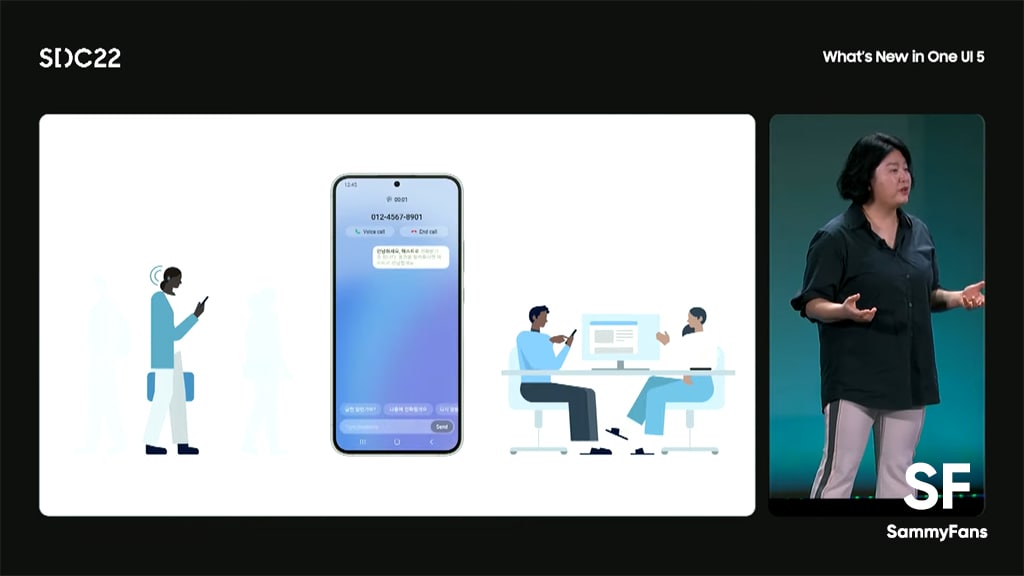News
Samsung launches Bixby Text Call in India: How to setup/use, supported devices

Samsung officially released the Bixby Text Call feature in India. Using this feature, Galaxy users can allow Bixby to answer and respond to incoming calls.
Follow our socials → Google News | Telegram | X/Twitter | Facebook | WhatsApp
Bixby’s automated voice will answer your incoming calls, then, you can simply start typing with the keyboard, and Bixby will read your messages to the caller. Once a call is over, you can look back on your conversations if needed.
Supported devices
Samsung’s Bixby Text Call is available on Fold5/Flip5, Fold4/Flip4, Fold3/Flip3, Fold2/Flip/Flip 5G/Fold 5G, S23/S23+/S23 Ultra, S22/S22+/S22 Ultra, S21/S21+/S23 Ultra, S20/S20+/S20 Ultra, A34, A54, A52s 5G, A82 5G, A53 5G, A33 5G, S20 FE, Note 20/ Note 20+, A71 5G and A51 5G.
How to set up Bixby Text Call
If your phone supports Bixby Text Call, you can enable the feature by doing the following:
- Open the Phone app, tap on More Options (the three vertical dots), and then tap on Settings.
- Tap on Bixby text call and then turn on the feature in the Bixby text call window.
- If you have not installed language package already, you will be prompted to download a language package.
- Tap Download and then click on Continue to go to the Galaxy Store where you can Install the language package.
- Once you have turned on Bixby text call, you can further edit Bixby text call settings such as language and voice. You can also add new quick responses or customize existing ones for Bixby text calls.

How to use Bixby Text Call
Note that Bixby Text call can be used only during incoming calls. Although you will not be able to hear the conversation, you can read the messages during the call. The caller will only hear an automated voice.
- Once you have turned on the feature, you can see Bixby text call when you receive a call. Tap on that. On the next screen, swipe up on the green coloured icon to initiate a Bixby text call.
- Bixby will let the caller know you are using an automated voice. Bixby will also ask the caller who they are and why they are calling.
- Once the caller begins speaking, you will see their response transcribed on the screen.
- You can reply to the caller by selecting a quick response at the bottom of the screen, or typing what you would like to say. Tap Send. Bixby will then read your response to the caller.
- If you would like to stop using Bixby text call and switch to a voice call instead, tap Voice call at the top of the screen.
- Tap End call at the top of the screen to end the call.

// Samsung
News
Here’s why Google Messages replaced Samsung Messages on Galaxy devices

Samsung’s latest foldable phones come with Google Messages by default. The company has now revealed the reason behind this move on Galaxy devices. Samsung says Google Messages replaced Messages to foster RCS adoption.
According to AndroidAuthority, a source explained Samsung’s decision to switch to Google Messages as the default messaging app. The recently released Galaxy Z Flip 6 and Z Fold 6 come with Google Messages with RCS enabled by default.
Looks like promoting Google Messages on Galaxy devices will boost RCS adoption. Samsung Messages isn’t already installed on newer phones. However, one’s stopping you from getting it on your Galaxy from the Galaxy Store.
While many apps support the RCS feature, Google Messages offer the best user experience. Making it a default messaging app is an effort to boost the adoption of RCS tech. Apple is also preparing to bring RCS chat functionality to iMessage for iPhones.
What Samsung source said:
- Even if messaging apps follow the RCS standard, the availability may be limited depending on which app the other party uses. That’s why we decided to make Google Messages the common messaging platform, allowing Galaxy users to communicate more freely. This also enables a messaging app to respond to changes of the RCS standard more quickly and efficiently.
Previously, Samsung devices launched in the US came with two messaging apps. This time, the company has removed the Samsung Messages. During the first setup, users are notified that Google Messages is the default messaging application.
News
Samsung SmartThings gets ISO 27001 certified

Samsung SmartThings gained the international standard ISO/IEC 27001:2022 certification. The company has officially announced this major development in its global connected living platform.
SmartThings received ISO/IEC 27001:2022 certification for information security management systems. Certification reiterates that the SmartThings Cloud operates per international standards.
To be certified, a company has to meet the standard across a total of 123 detailed items, including policies for information security, access control for information assets, and incident response.
SmartThings receiving the ISO 27001 certification is the result of our sustained focus on the protection of information in a hyper-connected world with exponentially increasing intelligence.
Seungbum Choi, Executive Vice President and Head of Device Platform Center at Samsung Electronics said “this is just another step in our drive to fortify the platform’s security. We will continue to find new ways to ensure that SmartThings’ personalized services are provided even more safely.”

BSI Prez says that they have recognized that the operation capability and security level of Samsung SmartThings is excellent. It will further boost trust in the SmartThings platform and strengthen business competitiveness.
ISO 27001 is the leading global standard for ISMSs and was established by the International Organization for Standardization. It provides companies with guidance to manage the risks to information assets systematically and achieve information protection goals.
News
Dr.diary fuels Samsung Health with glycated hemoglobin algorithm
Samsung Health app integrated the Dr.diary (Doctor Diary) glycated hemoglobin feature. The blood sugar management platform announced the launch of its glycated hemoglobin estimation functionality on Samsung’s Health application.
According to ETNews, Dr.diary announced the integration of a glycated hemoglobin level feature in Samsung Health. Galaxy users will now be able to check the estimated glycated hemoglobin level provided by Doctor Diary.
To activate the feature, Health app users will have to permit certain conditions of data in the Blood Sugar service. It is worth noting that glycated hemoglobin is a key figure for diabetes diagnosis, which users will find worth using in the Health app.
Established in 2017, Dr.diary is a blood sugar management platform. It analyzes and predicts the changes in glycated hemoglobin using its own algorithm. Earlier this year, the firm secured a patent for “glycated hemoglobin estimation based on blood sugar data table.”
Song Je-yoon, CEO of Doctor Diary, said, “With our predicted glycated hemoglobin level prediction algorithm being installed in Samsung Health, more people will be able to recognize their glycated hemoglobin level and manage their health more efficiently.”

Glycated hemoglobin (HbA1c) is a standardized numerical value of the percentage of hemoglobin, such as hemoglobin, which has been glycated by glucose. Glycated hemoglobin reflects the average blood sugar level over the past 2-3 months.
Samsung Health (with Wear OS Galaxy Watch) users can conveniently check their estimated glycated hemoglobin level within the app and use this information to manage their blood sugar levels through diet and exercise.












